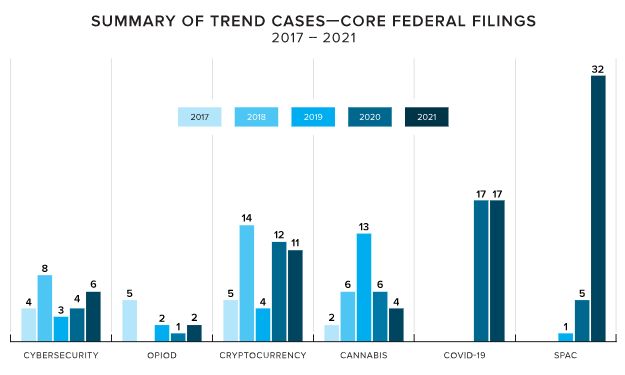2021 was a light year for new securities class actions. According to reports by NERA Economic Consulting and Cornerstone Research and the Stanford Law School Securities Class Action Clearinghouse, plaintiffs filed only 218 securities class action cases in federal and state court in 2021– a 35% drop from 333 cases filed in 2020.
Both reports suggest this decline was fueled by a substantial decrease in mergers and acquisitions class actions. The Cornerstone/Stanford report identifies decreases in (1) federal insider trading filings and (2) state court filings under the Securities Act of 1933 as contributing factors. Additionally, the maximum dollar value of the claims filed saw a 41% decline in 2021. Professor Joseph A. Grundfest, director of the Stanford Law School Securities Class Action Clearinghouse and a former commissioner of the Securities and Exchange Commission, told the National Law Review that "[t]he decline is attributable largely to a dearth of 'mega filings'—claims with theoretical damages exceeding $10 billion."1 According to Grundfest, the "dollars at stake" decrease is a more useful statistic for investors and plaintiffs' lawyers than the number of new cases, since it indicates the monetary risk at issue for current cases. He also posited that the decrease in activity could be explained by the strength of the stock market during 2021.
Despite this drop, experts anticipate the decline to reverse in 2022, predicting a busy year of securities litigation based on two indicators:
- First, while state court filings asserting claims under the Securities Act of 1933 fell, federal-only filings rose. Overall, the number of filings under Section 11 of the Securities Act stayed about the same year-over-year. Further, the NERA report notes that, although the 2021 numbers are a departure from 2017-2020 highs, they are still well within the pre-2017 historical range.
- Second, there is an increase in special purpose acquisition company ("SPAC") mergers, which have become a focus of the plaintiffs' bar. New cases with SPAC allegations also increased, despite the decrease in overall cases. According to Alexander Aganin, coauthor of the Cornerstone/Stanford Report and a Cornerstone Research senior vice president, "Over the last three years, roughly 13% of SPAC mergers were followed by securities litigation, typically within less than six months. This is slightly above the cumulative core litigation rate that recent newly public issuers face in the first two years after traditional IPOs."2 Along with this increase, federal SPAC filings increased more than six times from 5 in 2020 to 32 in 2021. Aganin predicts the increase in SPAC mergers, in conjunction with stock market volatility, will lead to a busy securities litigation season in 2022.
For now, it is too early to tell whether this decrease in securities class actions will continue in 2022, or simply reflects a calm before the storm. But with the stock market on less sure footing recently and more SPAC mergers on the horizon, it is likely to become clear soon.
Key Takeaways:
- New securities class actions were down by 35% in 2021 compared to 2020.
- Despite this drop, several SPAC mergers will close in the coming months, which may result in a busier securities litigation season in 2022.
Sources:
- https://www.cornerstone.com/wp-content/uploads/2022/02/Securities-Class-Action-Filings-2021-Year-in-Review.pdf
- https://securities.stanford.edu/
- https://www.cornerstone.com/insights/press-releases/securities-class-action-filing-activity-plummeted-in-2021/
- https://www.natlawreview.com/article/securities-class-action-filing-activity-plummeted-2021
- https://www.nera.com/publications/archive/2022/recent-trends-in-securities-class-action-litigation--2021-full-y.html

Note: M&A SPAC filings are excluded from this exhibit. There were five, two, and one of such filings in 2019, 2020, and 2021, respectively.
This chart is attributed to the "Securities Class Action Filings 2021 Year In Review" as published by Cornerstone Research and the Stanford Law School Securities Class Action Clearinghouse.
Footnotes
1.https://www.cornerstone.com/insights/press-releases/securities-class-action-filing-activity-plummeted-in-2021/.
2.https://www.cornerstone.com/insights/press-releases/securities-class-action-filing-activity-plummeted-in-2021/.
The content of this article is intended to provide a general guide to the subject matter. Specialist advice should be sought about your specific circumstances.




